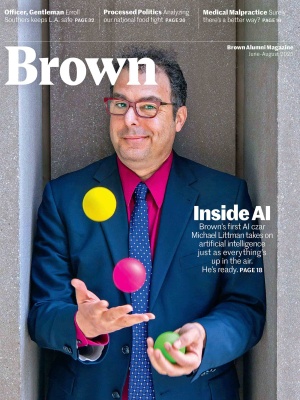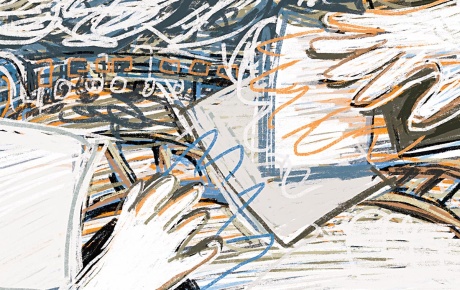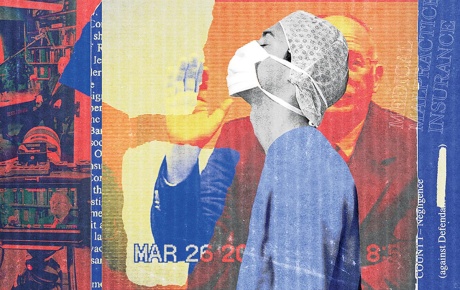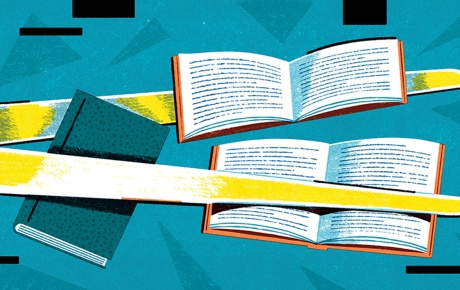
Man + Machine
Michael Littman ’96 PhD is known for his high-energy playfulness and the deep insights he honed as the NSF’s outgoing AI czar. Now, as Brown’s first associate provost for artificial intelligence, he has a campus-wide charge to steer the University through the tectonic shifts of machine learning—and thwart the paper-clip singularity.
On a breezy July morning in Alexandria, Virginia, Michael Littman ’96 PhD pulled up to the National Science Foundation on his electric unicycle, planning to conduct a little experiment on whether AI might try to destroy humanity.
Littman, who had just started his three-year term as the division director for Information and Intelligence Systems (IIS) at the National Science Foundation (NSF)—in layman’s terms, the foundation’s AI czar—entered the gleaming nineteen-story crescent of glass and steel, ambled across the lobby’s white marble floors dotted with security guards, suit-clad science experts, and guests on standby for badges, and pressed the elevator button.
A new colleague had complained that Littman hadn’t yet decorated his office. In response, Littman decided to test a theory of mass destruction. Exiting the elevator, he strolled through the maze of glass offices and water dispensers to begin addressing the bare walls.
He typed his request into DALL-E, the AI image generator: “Make a globe out of paper clips.”
If the world aligned with philosopher Nick Bostrom’s famous thought experiment on AI, Littman’s request would have triggered the apocalypse. “The system would reason, well, if I’m going to maximize paper-clip production, then what I need to do is not allow anybody to turn my systems off, which people could do. So I’m gonna kill all the people.” Littman explains, “In fact, I can reuse the iron in their blood to make paper clips. So I’m gonna recycle the people. In fact, I can actually turn the entire earth into paper clips, and probably the whole neighboring part of the solar system.”
The computer fan gave an ambiguous hum. The result could be office art or planetary extinction by AI. Not a minute later, the printer mildly ejected a glossy image of paper clips interlocking in the shape of the Earth.
In the spotlight
Just a few years earlier, Littman, a celebrated professor of computer science at Brown, had stood in a completely different world—one of bright stage lights, groovy music, and movement.
It was showtime. Alumnae Hall auditorium became a disco of flashing white and red light, filled with the sounds of clapping and fancy footwork. To usher in that year’s Dancing with the Profs, a Brown University annual tradition, the auditorium had been transformed into a dance floor.
After winning the award for “The Professor You Would Most Likely Accidentally Call Dad,” Littman gave his students a brief stand-up routine on dads vs. fathers.
As “Good Golly Miss Molly” began to blast from the speakers, a great spotlight illuminated Littman. Sporting a shiny black vest and dance pants, he loudly clapped to the beat of the drums. When he pointed at his dance partner [then-undergrad] Quynh Tran ’16, the spotlight flew over to Tran, who struck a pose, hands and polka-dotted pink skirt fanned out. The crowd roared in approval as Littman knee-slid over to her. Then the two dancers began to twist, turn, and shimmy to the rhythm.
While executing the fast-paced swing-dance choreography, Littman psyched himself up for the killer move. Tran stood at one end of Alumnae Hall, her back to him and legs spread dramatically shoulder-width apart.
The move he was about to make, a floor slide through the space between his dance partner’s legs, could be a pivotal moment of victory or potential medical disaster. He remembered how earlier, in rehearsal, he had crashed into a narrowly separated set of trash cans standing in for Tran’s legs, debris spilling across the wood-paneled floor.
Sweating, he began to spiral. “Oh, my! Gosh! I’m gonna kill this woman! This is gonna be terrible. I’m gonna wreck her legs. I’m gonna ruin her dancing career.”
He went for it—and to the cheers of students and professors in the audience, Littman found himself gliding out the other side to victory.
Performing and puzzles
Growing up in the Philadelphia suburbs, Littman felt the worlds of performance and coding crisscrossing in his life. Whether as a 13-year-old immersed in rudimentary computer programs from store-bought cassette tapes, or as an a cappella singer performing on holidays with the Littman Family Quartet, Littman was driven by curiosity, seeing humor and the potential for musical theater in just about everything.
Striving to merge his two cherished worlds into a lifelong career, Littman says: “I like to say that the two things that really are exciting to me are performing and puzzles. And so getting to be a professor was just such a great fit. Because how else can you do that?”
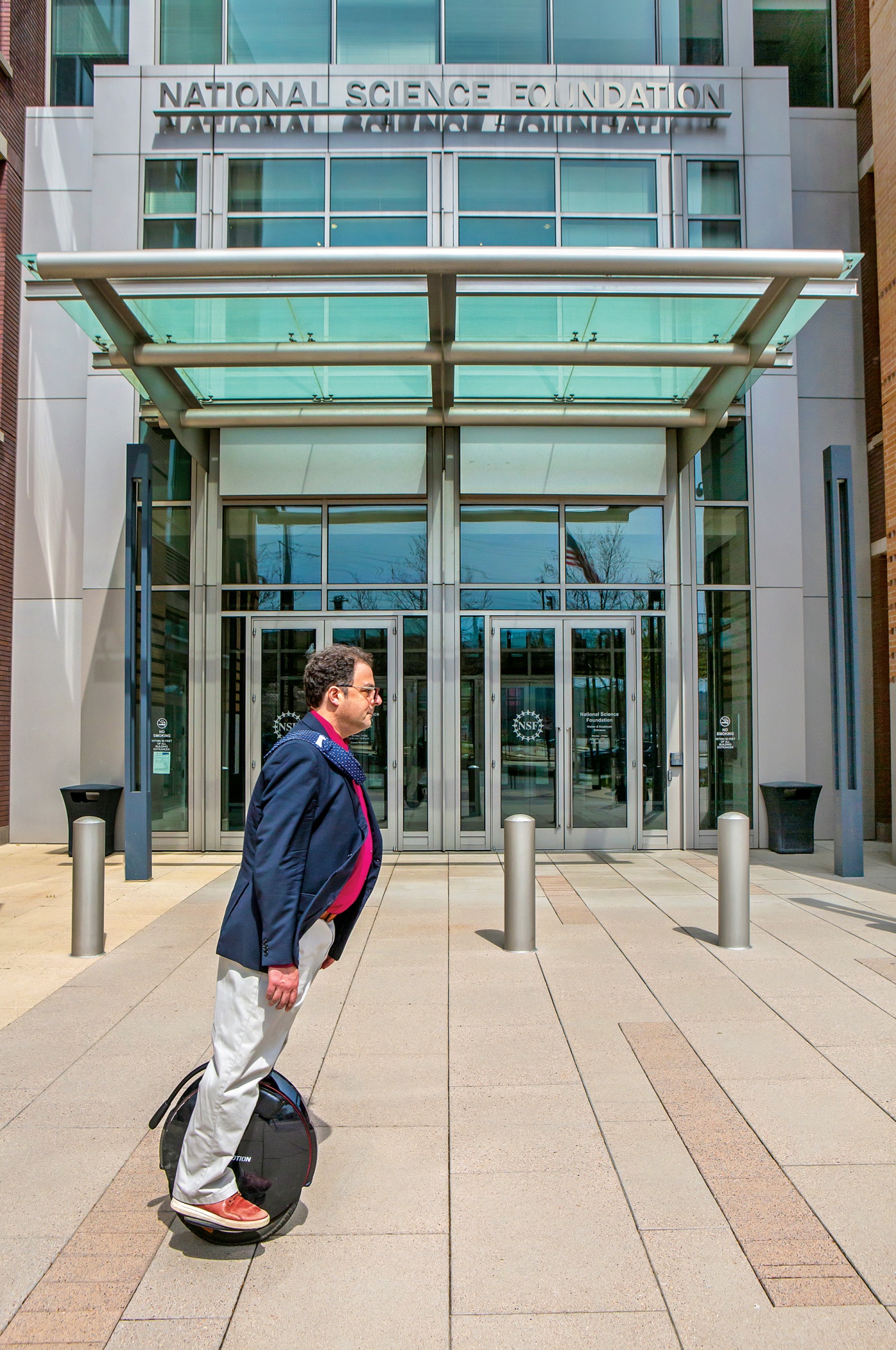
Set on teaching at Brown, his graduate-school alma mater, Littman applied and was passed over five times before becoming a professor of computer science at Brown in 2012. Since then, Littman has cofounded BIG-AI, the Brown Integrative General Artificial Intelligence group; served as associate department chair in 2018; and still codirects the Humanity-Centered Robotics Initiative with Bertram Malle. He’s also served on national boards, for example as general chair of the International Conference on Machine Learning in 2013. Littman’s awards alone run to two pages on his CV, including for papers with names like “Acting Optimally in Partially Observable Stochastic Domains” and “Markov games as a framework for multi-agent reinforcement learning.”
As tech-y as all that sounds—and is—take one look at his website, Littmania, or sit in on one of his lectures and that undeniable musical flair is on full display. In one of his videos, set to the tune of Michael Jackson’s “Thriller,” Littman, dressed in a red-and-black leather moto jacket, belts out lyrics on standard deviation and the Bellman equation—to the hums and harmonies of a student a cappella group.
In another class, after hearing some students say he makes “dad jokes” and winning the award for “The Professor You Would Most Likely Accidentally Call Dad” at a CS student end-of-year-party, Littman gave his students a brief stand-up routine on dads versus fathers before lecturing on machine learning. “I was basically riffing on how it is that Dad is associated with things like dad bods, dad jokes, and these are not good things as opposed to say, Father. You have, like father of the country, or father of the field, right? So I just kind of riffed on them, talked about what it’s like to be a dad.”
Among Littman’s teaching awards are Brown’s Philip J. Bray Award for Excellence in Teaching in the Physical Sciences; the Warren I. Susman Award for Excellence in Teaching, Rutgers University’s highest honor for outstanding and innovative performance in the classroom by a tenured faculty member; and Duke University’s Robert B. Cox Trinity College Distinguished Teaching Award.
To the tune of Michael Jackson’s “Thriller,” Littman, dressed in a red and black leather moto jacket, belts out lyrics on standard deviation and the Bellman equation.
At one point, Littman’s classroom antics landed him a role in a national advertisement for TurboTax. Littman recalls: “A family friend was bringing his daughter to check out Brown, and he asked, ‘Can we sit in on your class?’ and I was like, ‘Sure, I would love to have you.’ I did my thing and he contacted me a week or two later, saying, ‘Hey, so I’m actually in advertising.’ Apparently, they’d YouTube stalked me, and they asked me to be in a national commercial.” As a result, Littman in his appropriately “tech genius” outfit of a blue button-down and slacks hit millions of TV screens during NFL playoff games and Saturday Night Live—all thanks to the power of performance.
National AI strategy
When Littman got an invite from the NSF in 2022 to become their next AI Director, he thought he’d just missed the hype.
To Littman, 2016 had been the year for artificial intelligence. Google had released its first voice-activated smart speaker, Google Home, that would become a fixture in the living rooms of millions of people. DeepMind’s AlphaGo had just defeated the world champion Lee Sedol at Go, one of the world’s most complex strategy games, a feat accomplished a whole decade earlier than many thought possible.
Nestled in his third floor office at the CIT, Littman thought, “I missed the really exciting time, but AI’s still probably pretty cool. So I think I could be at NSF for a couple of years.”
Looking back, Littman laughs, “AI had not finished having its moment when I got here.”
Walking into HQ on his first day, Littman recalls: “They said, ‘Great, you’re now the cochair of the AI R&D IWG. And, by the way, as cochair, you’re responsible for writing the National AI R&D Strategic Plan.’ And I’m like, ‘What? Now?’”
Helping lead the AI Research and Development Interagency Working Group, or the AI R&D IWG (Washington D.C. is big on acronyms, Littman discovered), to Littman, was like entering a scene from Avengers: The Department of Justice. The FBI. The Patent and Trademark Office. He remarks in awe, “Sounds almost like something from a comic book. So that’s kind of cool. All these agencies that I only knew of as either words or background in some movie, like, they’re real people, and they’re doing real things. And I was helping to run the organization that was keeping everybody in the loop with each other.”
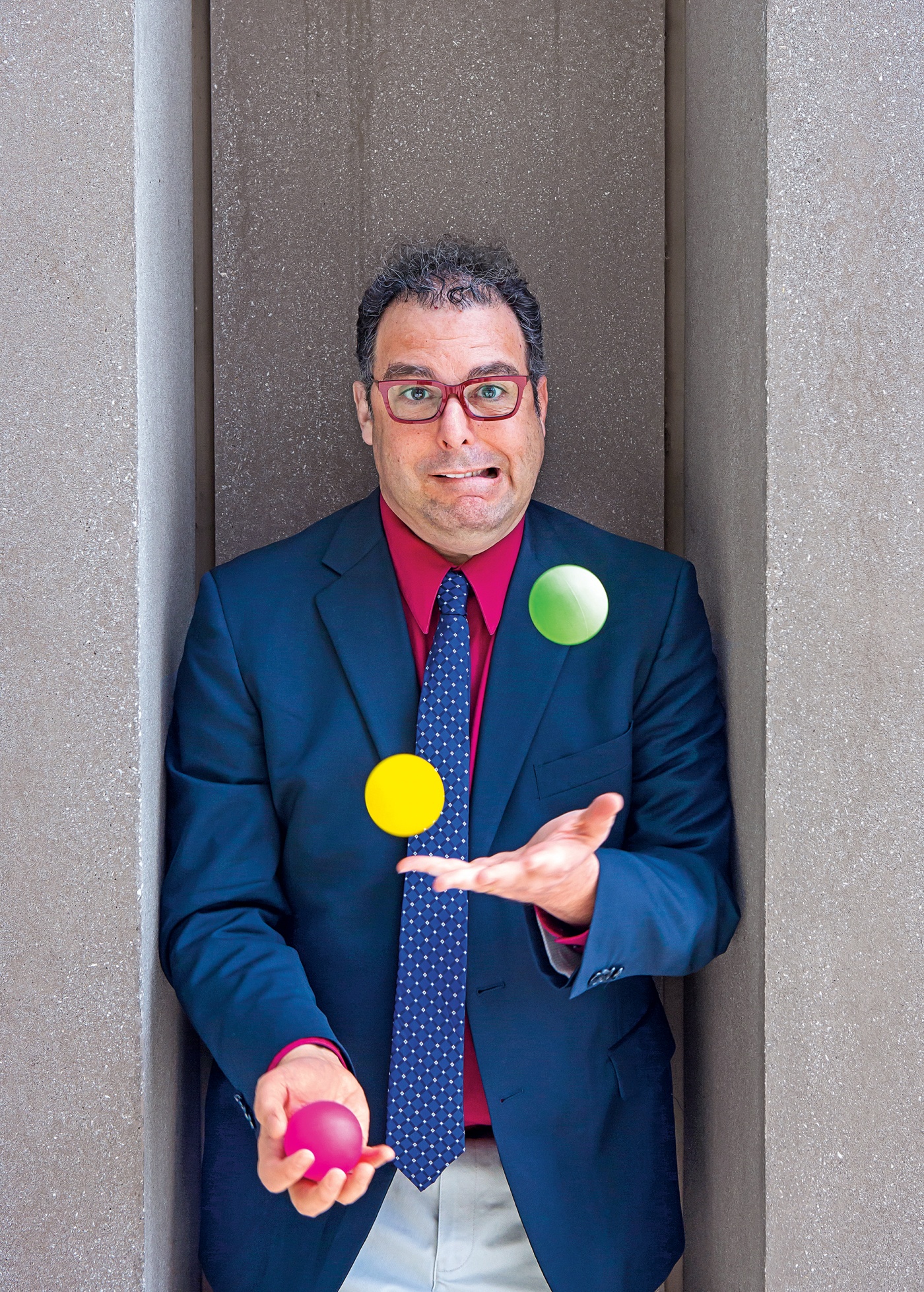
His team in developing the National AI Research and Development Strategic Plan included cochair representatives from the National Institute of Standards and Technology (NIST) and the Department of Energy. Among the strategic plan’s key priorities are increasing public access to dataset and AI training, incorporating ethical and legal implications into AI education, and communicating federal workforce priorities to stakeholders. Littman, as cochair of the committee charged with developing the strategic plan, acted as a key touchstone between policymakers, tech experts, and industry leaders at such stakeholder events. However, as serious as these events could be, occasionally Littman’s more laid-back, wise-cracking side slipped out.
Preparing to speak to Congressional staffers at the U.S. Capitol, Littman lingered beneath the landmark building’s iconic dome, its curved silhouette opening up to a grand marble rotunda. Littman knew what he had to say and how he had to say it. Today was all about “What is NSF? What is AI? What is the NSF strategy with respect to AI?” He took a breath and got up to the podium to speak.
Looking down at the crowd seated before him, Littman noticed that, instead of silver-haired senators, the eager faces of Congressional staffers, many in their 20s and 30s, stared up at him. “Bright, young people who are just fresh out of school—they’re the ones actually figuring things out and doing all the legwork,” Littman recalls. “It’s very impressive but it was so funny. It felt like lecturing in college. It was like college student or grad student faces in this room.”
He accidentally slipped into his professor persona. A joke here, a wry quip there.
“‘No jokes,’” warned the assistant director from Computer and Information Science and Engineering (CISE). “‘If you make a joke where you’re being a little bit cute, it’s really easy to take it out of context and make it look bad.’”
A new roadmap
In February 2025, just weeks into President Donald J. Trump’s second term, Littman appeared in a follow-up interview more subdued and circumspect. On his first day in office, Trump had issued the executive order “Removing Barriers to American Leadership in Artificial Intelligence,” thus revoking the Biden administration’s executive order on AI, which aimed to promote “safe, secure, and trustworthy development and use of artificial intelligence.” To Littman, “a thing that we spent basically two years trying to follow up on and get all the pieces to come together on was more or less taken off the table.”
Regarding his priorities at NSF, Littman remarks, “Oh boy, I actually had a bunch. But now every day there’s a new thing that we are asked to grapple with. It’s been nonstop whack-a-mole, so I don’t even know which of them are still valid.” With his contract at NSF set to end in July, Littman mourns the lost opportunities that the federal chaos has caused: “I don’t have a ton of time left and I was really hoping to get a couple of things done. I’m sad that I can’t even really work on them because of these emerging issues, but much higher priority items are facing the agency now.”

Another challenge has been the recent federal hiring freeze: “They won’t be able to replace me when I leave. We were going to be basically interviewing people soon and now that’s all shut down until January, and possibly indefinitely.”
While Littman felt AI would definitely be one of the Trump administration’s priorities, he maintains, “It’s really rough on everybody here who takes it as their mission to support the research enterprise across the entire country and has dedicated their lives to that. They feel very much like they themselves are being targeted.”
Before returning to Brown this summer, Littman says he hopes to finish up two projects—establishing an AI roadmap for NSF, one that could help introduce agency newcomers to NSF’s current AI portfolio and future initiatives, and coordinating a “mini internal educational push” on AI for non-AI folks at NSF.
“I’ve been away from Brown for three years and so kind of preparing lessons around AI for NSF staff is something I’m really pleased to get to do,” he says. “I miss teaching.”
AI for good
With his return to College Hill in July, Littman will both go back to teaching and take on a big new role as the University’s first associate provost for artificial intelligence. Littman was immediately drawn to the position when it surfaced on his employee portal in April 2024. “I really love the way that the job ad was written, actually, because it highlights five different areas.” Littman lists them off: “research, teaching, operations, policy, and communications. I mean, all these things are happening. The Brown campus is already abuzz with AI activity on all those fronts. So getting to be someone to help coordinate that across the entire campus across all these different efforts is really a wonderful opportunity.”
“What can we be doing to make AI something that empowers everybody on campus and gives us superpowers if possible? It’s just so exciting.”
In October, he applied, was interviewed, and given the offer. While Littman made his NSF contract end date known, his onboarding tasks started this January. Describing his role as “half in the provost’s office and half in the computer science department,” Littman spent a lot of time in January and February coordinating meetings with various leaders on campus, getting a broader view of the University while reconnecting with “old friends, people I knew in my previous role,” in a new context.
“One of the big reasons for trying to get up to speed quickly is because AI is moving really fast. We’d like to be able to let our alumni know what it is that we’re trying to do in case they have resources and are interested in helping. That means communicating a clear message to them about what we’re trying to accomplish, who’s on board, and how we’re going to do it.
“I’m really excited to be back on campus. I left during the pandemic, when the campus kind of felt weird. People were scattered, and it was all very Zoom-based. I feel like it’s been basically pre-pandemic since I’ve really gotten to have the Brown experience,” Littman says. “And so, as you might imagine, I’m really excited to be part of that again.”
As associate provost for AI, Littman is excited to help shape Brown’s campus-wide pursuit of AI for the common good. “What can we be doing to make this something that empowers everybody on campus and gives us superpowers if possible? It’s just so exciting and I feel like Brown is just the perfect place to do this kind of creative experimentation. There are just so many people with so many wonderful perspectives that I think we can blend together and do something very cool.”
Christine Baek ’25 is an international & public affairs and environmental studies concentrator.

